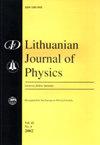A physical mechanism of sensitivity enhancement of organic X-ray detectors with tungsten nanoparticles
IF 0.3
4区 物理与天体物理
Q4 PHYSICS, MULTIDISCIPLINARY
引用次数: 0
Abstract
A simple theoretical model explaining the increase of X-ray sensitivity caused by adding tungsten nanoparticles into thin layers of organic materials is proposed. The mentioned increase of sensitivity is caused by quenched electron multiplication due to secondary electron emission from tungsten particles. After some simplifying assumptions, an expression of the electron multiplication factor K is derived for the case when tungsten atoms are uniformly mixed with the matrix material. The main assumption of the model is the existence of a threshold energy Emin of the order of 0.1 eV, below which the recombination of charge carriers prevents them from being accelerated by the electric field to energies sufficient for impact ionization. It is shown that this assumption makes the increase of K and photocurrent with increasing electric field much slower than the exponential increase commonly associated with an electron avalanche, and K may even start to decrease when the electric field strength exceeds a certain value. Another factor, which has an adverse effect on the X-ray sensitivity, is the ionization energy loss of photoelectrons inside metallic nanoparticles. The results of Monte Carlo simulations show that in the case of spherical tungsten particles with 0.8 μm diameter, the latter phenomenon may cause an additional decrease of the sensitivity by as much as 75%. In order to reduce this effect, the size of nanoparticles should be reduced, or, alternatively, most of the photoelectrons should be generated in the organic matrix rather than inside the nanoparticles.纳米钨增强有机X射线探测器灵敏度的物理机制
提出了一个简单的理论模型来解释在有机材料薄层中添加钨纳米颗粒引起的X射线灵敏度的增加。上述灵敏度的增加是由钨颗粒的二次电子发射引起的猝灭电子倍增引起的。在一些简化的假设之后,导出了当钨原子与基体材料均匀混合时电子倍增因子K的表达式。该模型的主要假设是存在0.1eV量级的阈值能量Emin,低于该阈值能量,电荷载流子的复合防止它们被电场加速到足以进行碰撞电离的能量。结果表明,这种假设使得K和光电流随电场增加的增加比通常与电子雪崩相关的指数增加慢得多,并且当电场强度超过一定值时,K甚至可能开始减少。另一个对X射线灵敏度有不利影响的因素是金属纳米颗粒内光电子的电离能损失。蒙特卡罗模拟结果表明,在直径为0.8μm的球形钨颗粒的情况下,后一种现象可能会导致灵敏度进一步降低75%。为了减少这种影响,应该减小纳米颗粒的尺寸,或者,大多数光电子应该在有机基质中产生,而不是在纳米颗粒内部产生。
本文章由计算机程序翻译,如有差异,请以英文原文为准。
求助全文
约1分钟内获得全文
求助全文
来源期刊

Lithuanian Journal of Physics
物理-物理:综合
CiteScore
0.90
自引率
16.70%
发文量
21
审稿时长
>12 weeks
期刊介绍:
The main aim of the Lithuanian Journal of Physics is to reflect the most recent advances in various fields of theoretical, experimental, and applied physics, including: mathematical and computational physics; subatomic physics; atoms and molecules; chemical physics; electrodynamics and wave processes; nonlinear and coherent optics; spectroscopy.
 求助内容:
求助内容: 应助结果提醒方式:
应助结果提醒方式:


